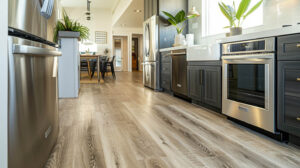
Pavimento SPC (Pedra Plástica Composta)1 has gained significant traction in both residential and commercial applications due to its durability, water resistance, and aesthetic versatility. Behind its success lies a sophisticated production process and a carefully selected combination of materials.
[SPC flooring]is manufactured using advanced extrusion techniques and a precise mix of raw materials like limestone powder, PVC resin, and stabilizers. These components work together to create a product that is both functional and stylish.
This report provides a comprehensive analysis of SPC flooring production, including its manufacturing process, material composition, and expansion properties.
[Índice].
Como é fabricado o pavimento SPC?
[SPC flooring] is produced through a series of high-precision processes that ensure its quality and performance.
SPC flooring is produced through extrusion, where raw materials are combined, melted, and formed into rigid boards. These boards are then laminated with decorative and protective layers.
Dive Deeper into SPC Manufacturing
1. Raw Material Preparation
The process begins with the mixing of limestone powder, PVC resin, stabilizers, and additives. This mixture is carefully balanced to ensure consistency and performance.
2. Extrusão
The mixed materials are fed into an SPC [extrusion machine], where they are melted under high heat and pressure. The melted composite is then shaped into sheets or boards with precise thickness and density.
3. Laminação
A decorative film layer and a transparent wear layer are applied to the rigid core. These layers are bonded using heat and pressure, giving the flooring its aesthetic and protective qualities.
4. Corte e perfilagem
The laminated boards are cut into planks or tiles of various sizes and equipped with click-lock edges for easy installation.
5. Controlo de qualidade
Every batch of SPC flooring undergoes strict quality checks to ensure it meets durability, waterproofing, and aesthetic standards.
| Etapa | Descrição |
|---|---|
| Mistura de matérias-primas | Combina ingredientes |
| Extrusão | Shapes rigid core |
| Laminação | Adiciona camadas decorativas |
| Corte/perfilagem | Finalizes dimensions |
| Controlo de qualidade | Assegura padrões elevados |
Quais são as matérias-primas do pavimento SPC?
O raw materials2 used in SPC flooring are the foundation of its strength and performance.
SPC flooring primarily uses limestone powder, PVC resin, stabilizers, and additives, all of which contribute to its durability and functionality.
Mergulhar mais fundo nas matérias-primas
1. Pó de calcário
Limestone powder3 is the primary filler, providing rigidity and density. It makes up a significant portion of the SPC core.
2. Resina de PVC
PVC resin acts as the binding agent, offering flexibility and resistance to moisture and chemicals.
3. Estabilizadores
Stabilizers improve thermal stability, ensuring the flooring maintains its shape and structure under varying temperatures.
4. Aditivos
- UV Inhibitors: Protect against fading from sunlight.
- Retardadores de fogo: Reduce flammability for added safety.
- Plastificantes: Enhance flexibility and processability.
| Material | Função |
|---|---|
| Pó de calcário | Proporciona rigidez |
| Resina de PVC | Binds components |
| Estabilizadores | Assegura a estabilidade |
| Aditivos | Improve properties |
Quais são os materiais do pavimento SPC?
Pavimento SPC4 is composed of multiple layers, each serving a specific purpose to enhance its performance and durability.
The main materials in SPC flooring include a rigid core layer, a decorative film layer, and a transparent wear layer. These layers are fused together for maximum efficiency.
Dive Deeper into SPC Flooring Materials
1. Camada de núcleo rígido
Made from a blend of limestone powder and PVC resin, this layer provides structural integrity and stability.
2. Camada de película decorativa
The decorative layer mimics the look of natural materials like wood or stone, offering a wide variety of designs.
3. Transparent Wear Layer
A high-density protective coating that resists scratches, stains, and everyday wear and tear.
4. Camada de suporte opcional
Some SPC flooring products include an acoustic or foam backing for added soundproofing and comfort.
| Camada | Objetivo |
|---|---|
| Núcleo rígido | Structural integrity |
| Camada decorativa | Aesthetic appeal |
| Camada de desgaste | Surface protection |
| Camada de suporte | Soundproofing |
Does SPC flooring expand and contract?
Temperature fluctuations can affect many flooring materials, raising questions about SPC flooring’s stability5.
SPC flooring exhibits minimal expansion and contraction due to its rigid core, making it more stable than traditional vinyl or laminate flooring.
Dive Deeper into Expansion and Contraction
How SPC Flooring Resists Movement
The limestone-filled core minimizes thermal expansion, ensuring dimensional stability even in environments with fluctuating temperatures.
Considerações sobre a instalação
Despite its stability, manufacturers recommend leaving a small expansion gap during installation to accommodate any potential movement.
Comparação com outros tipos de pavimentos
- Pavimentos SPC: Minimal expansion and contraction, suitable for areas with temperature changes.
- Pavimentos laminados: Prone to significant movement, requiring larger expansion gaps.
- Pavimentos de madeira: Expands and contracts considerably with humidity and temperature changes.
| Tipo de pavimento | Expansão/Contração | Estabilidade |
|---|---|---|
| Pavimentos SPC | Mínimo | Elevado |
| Pavimentos laminados | Moderado | Médio |
| Pavimentos de madeira | Elevado | Baixa |
Conclusão
[SPC flooring’s production process], raw materials, and layered composition make it a durable, water-resistant, and aesthetically versatile option. Its minimal expansion and contraction properties further enhance its suitability for both residential and commercial spaces.
Notas de rodapé:
-
Explains the step-by-step production process of SPC flooring, including extrusion and lamination ↩
-
Details the key raw materials like limestone powder, PVC resin, and stabilizers ↩
-
Highlights how limestone improves rigidity and stability in SPC flooring ↩
-
Explains the composition of SPC flooring, including the rigid core, decorative, and wear layers ↩
-
Describes the thermal stability of SPC flooring and its resistance to expansion and contraction ↩


